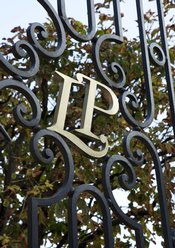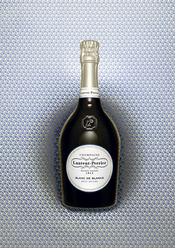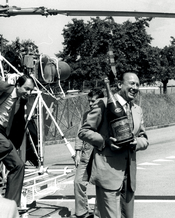First, let me give a little background of this great, but not that well-known house (at least in the U.S.). It is one of the earliest existing Champagnes–founded in 1812. Laurent-Perrier remains the largest family-owned Champagne house and the largest female-run house.
Laurent-Perrier is the fifth-largest Champagne in sales (after Moët & Chandon, Veuve Clicquot, the relatively new co-operative, Nicolas Feuilatte, and G.H. Mumm). Also included in the Laurent-Perrier ownership is Salon (one of the world’s greatest Blanc de Blancs Champagnes), Delamotte, and De  Castellane. Laurent-Perrier utilizes over 1,200 grape growers for its Champagnes, and exports the wines to more than 120 countries.
Castellane. Laurent-Perrier utilizes over 1,200 grape growers for its Champagnes, and exports the wines to more than 120 countries.
Laurent-Perrier is now run by the two daughters of the amazing Bernard de Nonancourt, Alexandra and Stéphanie de Nonancourt. Bernard de Nonancourt, when 28 years old, took over the helm of this small, family-run house in 1948, ran it for 60 years, and made Laurent-Perrier the superb, globally-renowned house that it is today. De Nonancourt died in 2010 (see my endnote with an aside on one of the amazing aspects of his life).
Laurent-Perrier emphasizes Chardonnay in almost all of its Champagnes–with the notable exception of its best-selling Rosé, which is 100 percent Pinot Noir.
When tasting the Champagne recently, the first change I noted in Laurent-Perrier has been in its largest-selling Champagne, its non-vintage brut, La Cuvée. Two years ago, La Cuvée modified its cépage to 55% Chardonnay (with 35% Pinot Noir and 10% Pinot Meunier). Previously, La Cuvée had contained 45% Chardonnay. Additionally, Laurent-Perrier now ages its NV Brut Champagnes in their cellars for four years; most other NV Bruts receive a maximum of three years aging.
The new La Cuvée was served in a magnum, and it was easily the best NV Brut Laurent-Perrier I have ever tasted. It displayed delicacy and elegance. I rated it 92. As much as 55% Chardonnay is almost unheard of in NV Bruts–by far the largest type of Champagne produced–primarily because Chardonnay is the most expensive grape variety grown in Champagne, and the most in demand. And yet the average price of the La Cuvée NV Brut is in the $35 to $43 range for the 750ml bottle, with the magnum in the $75 to $80 range–quite a bargain for a Champagne of this quality.
Nowadays, almost every Champagne house makes a Brut Nature (zero-dosage). Laurent-Perrier first made a zero-dosage Champagne in the 19th century, and resurrected this style when it introduced its Ultra-Brut in 1981, long before zero-dosage Champagnes became the hot, “new” style. In truth, climate change probably has had the most to do with the new-found popularity of Brut Nature Champagnes. As the Champagne region became relatively warmer, the riper grapes did not need as much dosage as before. In addition, Laurent-Perrier purchased more Chardonnay vineyards in 2004; these grapes have contributed a great deal to Laurent-Perrier’s excellent, new Blanc de Blancs Brut Nature, which will be launched in the U.S. in September, 2019. Laurent-Perrier has decided to make its Brut Nature a NV Blanc de Blancs, which in Champagne means 100% Chardonnay. It will have aged six years before being released.
This new Blanc de Blancs is based on the very good 2012 vintage, with about  40% from 2009. It is a solid, concentrated Champagne, with delicate honey and mushroom flavors. Michelle Defeo called it subtle, stating that “Subtlety is the power of a Blanc de Blancs.” One taster thought that its fruitiness made it hard to believe that it was a Brut Nature. Less than 1,000 cases have been produced, and the U.S. will be a main market. Laurent-Perrier’s previous Blanc de Blancs (not a Brut Nature) averaged about $66 retail; the new Blanc de Blancs Brut Nature will have a “Suggested Retail Price” of $89. This Champagne will be a bridge in Laurent-Perrier’s portfolio between its NV brut, La Cuvée, and its prestige cuvée, Grand Siècle. I rated it 94.
40% from 2009. It is a solid, concentrated Champagne, with delicate honey and mushroom flavors. Michelle Defeo called it subtle, stating that “Subtlety is the power of a Blanc de Blancs.” One taster thought that its fruitiness made it hard to believe that it was a Brut Nature. Less than 1,000 cases have been produced, and the U.S. will be a main market. Laurent-Perrier’s previous Blanc de Blancs (not a Brut Nature) averaged about $66 retail; the new Blanc de Blancs Brut Nature will have a “Suggested Retail Price” of $89. This Champagne will be a bridge in Laurent-Perrier’s portfolio between its NV brut, La Cuvée, and its prestige cuvée, Grand Siècle. I rated it 94.
Bernard de Nonancourt introduced Grand Siècle 60 years ago. He was a firm believer that a blend of vintages was always a better way to make Champagne than using a single vintage. He decided to defy convention in Champagne and make his prestige cuvée, Grand Siècle, a blend of three vintages, and to use just Chardonnay and Pinot Noir; every Grand Siècle is made of 55% Chardonnay and 45% Pinot Noir. The first Grand Siècle, launched in 1959, was a blend of 1952, 1953, and 1955. The Chardonnay for Grand Siècle comes from the best plots of seven Grand Cru village vineyards in the Côte des Blancs; the vintages that are used range from “very good” to “excellent.” The blended wine is then aged during the second fermentation on the yeast for five to eight years, depending upon cellar master Michel Falconnet’s judgment. It is then aged until it is ready to be released (at least 11 years after the youngest of the three vintages in the Grand Siècle).
But the problem with Grand Siècle has always been, “Which vintage-blends am I drinking?” After all, some vintage blends will always be better than others. Laurent-Perrier has finally solved this problem. Now, all Grand Siècle Champagnes will be numbered, and we can easily find out the vintage-blends from the number. The average retail price of the latest Grand Siècle released is $140, but the Champagne can sell as low as $120. Only the first two Grand Siècles listed are currently available. I tasted five numbered Grand Siècles last month: the following notes reveal the vintage-blends and my opinion of these Grand Siècles:
Grand Siècle # 24: The latest Grand Siècle: it will be released in September; Vintages: 2007, 2006, 2004. Disgorged in early 2019. Excellent Champagne: fresh, deep, concentrated; very long finish; touch of caramel; very young, will age for decades. 95
Grand Siècle # 23: Vintages 2006, 2004, 2002. A particularly fine group of vintages, # 23 was my second-favorite; it is lovely, full, and rich; great depth; excellent structure; clearly an exceptional prestige cuvée; disgorged in early 2018. 97
Grand Siècle # 22: Vintages 2004, 2002, 1999. Disgorged in late 2018. Woodsy, complex aromas; great depth; very concentrated on the finish; a rich Champagne; will age well. 96
Grand Siècle # 20: Vintages 1999, 1997, 1996. Outstanding. Still firm and austere; very energetic, great depth and concentration. Touches of coffee, cocoa, and orange rind. Disgorged in late 2017. This Grand Siècle is on another level. Not yet released! 99
Grand Siècle # 17: Vintages 1995, 1993, 1990. Disgorged in early 2017. Harmonious, vibrant, and alive; the first Grand Siècle of the group that I consider ready to drink; although enjoyable now, it will last for several years, thanks to the 1995 vintage. 95
Laurent-Perrier’s house style emphasizes freshness, elegance, and finesse across its entire range of Champagnes. None of the wines are aged in oak. Laurent-Perrier makes fewer single-vintage wines than most other houses. The art of blending–not just of grapes but of years, is a fundamental belief of Laurent-Perrier. In my opinion, it is an underrated Champagne in the U.S., especially its prestige cuvée, Grand Siècle. And the price of its Champagnes, especially Grand Siècle, is a real value compared to its competitors. It is a Champagne to seek out.
 de Nonancourt, an owner of Lanson Champagne; she purchased Champagne Laurent-Perrier for her sons just prior to the start of the War, in 1938. Both sons fought in WWII and Maurice was killed. During the final days of the War, Bernard was part of the group who broke into Hitler’s hideaway, the “Eagle’s Nest,” high up in the Bavarian Alps. Bernard found Hitler’s wine stash after blowing open an armored door, more than 500,000 bottles of great wines and Cognac, mainly stolen from France during the Nazi occupation. Among the prizes Nonancourt found were more than 100 cases of the legendary 1928 Champagne Salon. Bernard de Nonancourt was to later buy Champagne Salon in 1989 for his Laurent-Perrier Group.
de Nonancourt, an owner of Lanson Champagne; she purchased Champagne Laurent-Perrier for her sons just prior to the start of the War, in 1938. Both sons fought in WWII and Maurice was killed. During the final days of the War, Bernard was part of the group who broke into Hitler’s hideaway, the “Eagle’s Nest,” high up in the Bavarian Alps. Bernard found Hitler’s wine stash after blowing open an armored door, more than 500,000 bottles of great wines and Cognac, mainly stolen from France during the Nazi occupation. Among the prizes Nonancourt found were more than 100 cases of the legendary 1928 Champagne Salon. Bernard de Nonancourt was to later buy Champagne Salon in 1989 for his Laurent-Perrier Group.
